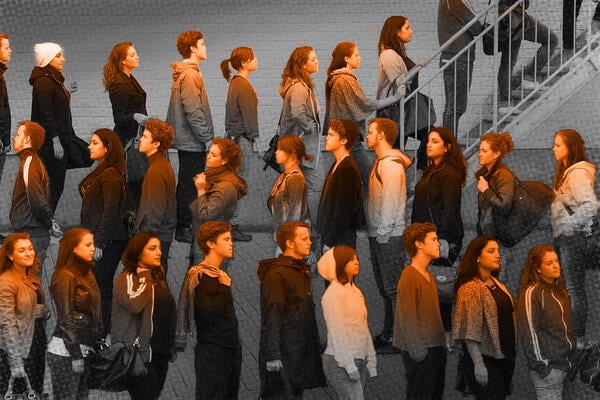
International Students Face Visa Issues Into Fall Semester
This week marked the start of the semester for hundreds of colleges across the U.S. But many international students, plagued by difficulty getting visa appointments and unusually high rates of visa denials, are still unsure if they’ll be able to attend college in the U.S. this year.
At the University of Maryland Baltimore County, a midsize public university that has a student body composed of about 15 percent international students, international Ph.D. and undergraduate students appear to be largely unaffected by visa issues. But the rate of visa issuance for master’s students is only about half what it has been in previous years, according to David Di Maria, UMBC’s vice provost for global engagement.
Most of UMBC’s master’s students are from India, the country that now sends the most international students to the U.S.—but which experts say has had virtually no visa appointments available for the past several months.
“I think what has impacted that population the most is that you’ve got a country where … you could probably guess, it’s the highest volume in terms of students visa applications at a time when there are fewer slots available,” Di Maria said. “Hopefully it’s a blip. Hopefully, in future terms, there won’t be an extended period where students are unable to secure visa appointments.”
The backlog in visa appointments dates to the Trump administration’s pause on all student visa interviews in late May, after which the government began mandating social media reviews for all F-1 visa applicants. Some experts argue that the mandatory social media reviews have also extended the visa process by adding more responsibilities to the workload of consulate staff.
Since then, experts have speculated about how significant the drop in international student enrollment will be this fall. NAFSA, the association that represents international education professionals, predicted earlier this summer that international enrollment would drop between 30 and 40 percent, resulting in $7 billion in lost revenue and 60,000 lost jobs. Experts warn that a dip that significant could have major repercussions for the economies of college towns and cities. Colleges may also have to scramble to find professors to lead low-level classes that international graduate students were slated to teach.
Stuck In a Holding Pattern
It’s difficult to tell if those projections are accurate. The Department of State hasn’t updated visa issuance numbers since May, at which point figures were already lower than they had been the previous year.
But now, the picture of what this academic year might look like is beginning to take shape as institutions and experts report that significant numbers of international students are stuck in a holding pattern, unable to find visa appointments even after the semester has begun.
“I actually joined a WhatsApp group in April … of all these Indian students who are aspiring to study in the U.S. this fall, and I [see] a lot of students saying, ‘No slots, no slots,’” said Girish Ballolla, chief executive officer of Gen Next Education, an international recruitment firm. “Basically, what they’re saying is they’re going online trying to schedule an appointment and they’re not finding any slots. Those students are, like, now talking about, ‘Oh, should I defer to spring? Should I take up my university’s offer of an online program?’”
Other countries with severely limited appointments include China, Japan and Nigeria, according to NAFSA.
Inside Higher Ed reached out to over 30 universities with significant international student enrollment to ask how many of their committed incoming students were unable to attend due to visa issues. Most did not respond; others declined to answer the question or said that data was not yet available.
A handful of institutions noted that they’ve had only a small number of students impacted by delays and denials; Grinnell College, located in Iowa, has only one international student out of 72 who was unable to come to campus due to visa delays. At Mount Holyoke College, “fewer than seven” students are still waiting on their visas, a spokesman said in an email, though he said other students had deferred until the spring. It’s not unusual for a small number of students to miss the start of the semester due to visa issues, even in a regular semester.
On the other hand, Cornell University, like UMBC, said some of its graduate students had trouble getting their visas—or were simply concerned about coming to the U.S.
“Cornell accepted roughly the same number of international students this year as in past years and roughly the same number accepted our offer as in the past, but we have experienced some melt at the graduate level as students were worried about the visa application process or chose not to come to the U.S. because of the political climate,” Wendy Wolford, vice provost for international affairs, told Inside Higher Ed in an email.
Grinnell, Cornell and Mount Holyoke, as well as UMBC, are among the 20 institutions with the highest proportion of international students in the U.S., according to The New York Times.
Visa Denials Are Up, Too
On top of having difficulty securing appointments, more students are having their visas denied, experts report.
Sudhanshu Kaushik, the director of the North American Association of Indian Students, said that students from the subcontinent are being denied at a higher rate than he’s seen in his five years leading the organization.
Many have been told the reason for their denial is because there’s not enough proof that they’re not attempting to immigrate to the U.S. That’s usual in some cases, Kaushik said, but it’s become common this year even among wealthier students from major cities with deep roots and connections in India.
“A demographic that’s never had an issue is facing lots of issues,” he said. He also noted that some students are receiving denials many weeks after their visa interview, in some cases getting the news just a few days before they were hoping to start classes.
Colleges are attempting to accommodate students facing visa delays and denials by offering them the chance to defer their admission until spring or take online classes, according to Joann Ng Hartmann, NAFSA’s senior impact officer.
“Schools are really thinking and working very hard to be flexible, because they want these international students on campus,” she said.
Cornell also devised what Wolford called a “global semester program” that will offer international students who couldn’t get their visas in time the option to spend their first semester at one of three international partner institutions before hopefully coming to Cornell in the fall.
Some students are still hoping they’ll make it to campus this semester, despite not receiving visas by orientation.
“At this point for us, the census date is Sept. 10, and that’s when we really know who’s here and who’s not,” said Di Maria of UMBC. “I do have a number of students who are still optimistic that say they would arrive later in the week, or even next week.”
Source link



